Editor's Staff
The Men and Women of the USPS
Legends of the West Series
The Legends of the West series came to be as First Day of Issue postcards from the United States Postal Service.
[Editor’s note:] It is no secret that most postcard collectors look like you and me. We are over 50, retired, and have 2.75 grandchildren. Thankfully our pensions are enough to support a collecting hobby with a very uncertain future. There are reasons for the uncertainty, and there is little we can do about most of them, but one thing we can do is encourage young collectors to join in the fun of postcards. A few weekends ago, I eves-dropped on a conversation between a lady and a gentleman who were old friends (obvious because she knew his grandchildren’s names). She was bragging to him about a find she made earlier that morning. She talked about finding a complete set of the 1994 USPS series, Heroes of the West for which she paid just twenty dollars. The set was to be part of a grandson’s birthday present.
The following day I searched for cards from that series and managed to find several. I studied each card and quickly came to the realization that among the personalities chosen for inclusion there were five men and one woman about which I knew nothing.
I have no intention of confessing the ways in which my education has faltered, so here is a checklist – illustrated and annotated. The sixteen people are listed alphabetically, left to right, with thumbnail bios following. Hope this is as much fun to see and use as it was to prepare.
Thanks goes to Wikipedia the online encyclopedia for the biographies (slightly edited). Each one is just enough to make you curious.
* * *
The Men and Women of the
USPS Legends of the West Series
James Pierson Beckwourth (born Beckwith, April 26, 1798 – October 29, 1866), was an American mountain man, fur trader, and explorer. Beckwourth was known as “Bloody Arm” because of his skill as a fighter. He was of mixed-races and born into slavery in Virginia. He was freed by his white father (and owner) and apprenticed to a blacksmith so that he could learn a trade.
James Felix “Jim” Bridger (March 17, 1804 – July 17, 1881) was an American mountain man, trapper, Army scout, and wilderness guide who explored and trapped in the western U. S. in the first half of the 19th century. He was known as Old Gabe in his later years. He was from the Bridger family of Virginia, English immigrants who had been in North America since the early colonial period. Bridger was part of the second generation of American mountain men and pathfinders who followed the Lewis and Clark Expedition of 1804 and became well known for participating in numerous early expeditions into the western interior.
Christopher Houston Carson (December 24, 1809 – May 23, 1868) was an American frontiersman. He was a wilderness guide, Indian agent, and U.S. Army officer. He became a frontier legend in his own lifetime through biographies and news articles, and much exaggerated versions of his exploits. His fearlessness, combat skills, tenacity, and profound effect on the westward expansion of the United States are legendary. Although he was famous for much of his life, historians in later years have written that Kit Carson did not like, want, or even fully understand the fame that he experienced during his life.
Ellen Cashman (1845 –January 4, 1925) was an Irish nurse, restaurateur, businesswoman and philanthropist in Arizona, Alaska, British Columbia, and the Yukon. She led a rescue party to miners in a gold mine in the Cassiar Mountains of British Columbia earning her the nickname “Angel of the Cassiar”. In Tombstone, Arizona, Cashman raised money to build the Sacred Heart Catholic Church and did charitable work with the Sisters of St. Joseph. During the Klondike Gold Rush she worked as a nurse for injured prospectors.
Hinmatóowyalahtq̓it or Chief Joseph, (March 3, 1840 – September 21, 1904), was a leader of the Wallowa band of Nez Perce, a Native American tribe from the interior Pacific Northwest. In the latter half of the 19th century, he succeeded his father (Chief Joseph the Elder). Chief Joseph led his band of Nez Perce during the most tumultuous period in their history, when they were forced from their ancestral lands in northeastern Oregon onto a reservation in Idaho.
There is much more legend than truth in the history of the Nez Perce War, among which can be found Joseph’s most famous words he never spoke. “I am tired of fighting. Our chiefs are killed; … The old men are all dead. It is the young men who say yes or no. He who led the young men is dead. It is cold, and we have no blankets; the little children are freezing to death. My people, some of them, have run away to the hills, and have no blankets, no food. No one knows where they are…. I want to have time to look for my children, to see how many I can find. Maybe I shall find them among the dead. Hear me, my chiefs! I am tired; my heart is sick and sad. From where the sun now stands, I will fight no more forever.
William Frederick Cody (February 26, 1846 – January 10, 1917), known as “Buffalo Bill,” was an American soldier and showman. He was born in Iowa, but he lived for several years in his father’s hometown in Ontario, Canada. At age 15 Cody became a rider for the Pony Express. During the Civil War he served the Union from 1863 to the end of the war in 1865 and later as a civilian scout for the army during the Indian Wars. He was awarded the Medal of Honor (later revoked) in 1872. Cody is best known for his Wild West Show that he performed both in America and Europe.
Wyatt Berry Stapp Earp (March 19, 1848 – January 13, 1929) was an American lawman in several early west cities, including Dodge City, Deadwood, and Tombstone. Earp took part in the famous gunfight at the O.K. Corral, during which lawmen killed three Cochise County cowboy-outlaws. He is regarded as the central figure in the shootout, although his brother Virgil was the Tombstone City Marshal and Deputy U. S. Marshal that day and had far more experience as a sheriff, constable, marshal, and soldier. Wyatt lived to age 80. He died at his home in Los Angeles, California.
John Charles Frémont (January 21, 1813 – July 13, 1890) was an American explorer, military officer, and politician. He was a U.S. Senator from California. In 1856, he was the first Republican nominee for president of the United States. Later in life Frémont was appointed governor of the Arizona Territory and served from 1878 to 1881. He spent little time in Arizona and was asked to resume his duties in person or resign; he resigned. In retirement Frémont lived on Staten Island, in New York. In April 1890, at age 77, he was reappointed as a major general and then added to the Army’s retired list, an action taken to ease his way to a government pension.
Geronimo (June 16, 1829 – February 17, 1909) was a prominent leader and medicine man from the Bedonkohe band of the Apache people. While he was a leader, he wasn’t a chief but rather a shaman. He is best remembered for how the United States government capitalized on Geronimo’s fame while he was a prisoner. He was literally “exhibited” at various fairs and exhibitions. He was forced to participate in the inaugural parade for President Theodore Roosevelt. He died at the Fort Sill (Oklahoma) hospital in 1909.
Charles Goodnight (March 5, 1836 – December 12, 1929), whose friends called him Charlie was an American rancher, perhaps the best-known rancher in Texas. He is sometimes known as the “father of the Texas Panhandle.” One way Goodnight earned his reputation was his “great gather” – in 1866 after the Civil War he led a near statewide round-up of the Texas longhorns that had roamed free during the four years of war. One era historian suggested that Goodnight “approached greatness better than any cow rancher in history.”
James Butler Hickok (May 27, 1837 – August 2, 1876), was better known as Wild Bill Hickok, a hero of the west known for his life as a soldier, lawman, gambler, showman, and actor, and his involvement in many famous gunfights. His personal stature – he stood six feet tall – helped him earn a great notoriety, much of it bolstered by the many outlandish and often fabricated tales he told on himself. The most famous Hickok story is about how he died.
On August 1, 1876, Hickok was playing poker in Deadwood, Dakota Territory. When a seat opened up at the table, a drunk man named Jack McCall sat down to play. McCall lost heavily. Hickok encouraged McCall to quit the game until he could cover his losses and offered to give him money for breakfast. Although McCall accepted the money, he was apparently insulted. The next day, Hickok was playing poker again. He usually sat with his back to a wall so he could see the entrance, but the only seat available when he joined the game was a chair facing away from the door. He twice asked another man at the table, Charles Rich, to change seats with him, but Rich refused. McCall then entered the saloon, walked up behind Hickok, drew his Colt “45” revolver, and shouted, “Damn you! Take that!” as he shot Hickok in the back of the head at point-blank range. Hickok died instantly. The cards he held were aces and eights, later known as the “dead-man’s hand.”
Bartholemew William Barclay “Bat” Masterson (November 26, 1853 – October 25, 1921) was an army scout, lawman, professional gambler, and journalist known for his exploits in the old west. He was born in Canada but moved to the Western frontier as a young man and quickly distinguished himself as a civilian scout and Indian fighter. He later earned fame as a gunfighter and sheriff in Dodge City, Kansas, during which time he was involved in several notable shootouts. Through mutual friends Masterson was introduced to President Theodore Roosevelt, and the two formed a friendship that resulted in Masterson being a frequent White House guest. Masterson’s fame today rests on his appointment as deputy U.S. Marshal for the Southern District of New York by President Roosevelt, a position he held until 1909. On October 25, 1921, at age 67, Masterson died at his desk from a massive heart attack after writing what became his final column for the Morning Telegraph. That last column included this statement “I suppose these ginks who argue that … because the rich man gets ice in the summer and the poor man gets it in the winter, things are breaking even for both. Maybe so, but I swear, I can’t see it that way.”
Phoebe Ann Mosey, known as Annie Oakley (born August 13, 1860 – November 3, 1926) was an American sharpshooter who toured in Buffalo Bill’s Wild West show. Oakley developed hunting skills as a child to provide for her impoverished family in western Ohio. At 15, she won a shooting contest against experienced marksman Frank E. Butler, whom she married in 1876. The pair joined Buffalo Bill in 1885, performing in Europe and throughout America. Audiences were astounded to see her shooting out a cigar from her husband’s lips or splitting a playing-card edge-on at 30 paces. She earned more than anyone except Buffalo Bill himself.
Willie M. Pickett (December 5, 1870 – April 2, 1932) was a cowboy and rodeo performer. Pickett was born in Texas in 1870. He left school after the fifth grade to become a ranch hand. He soon learned to ride horses and how to watch longhorn steers. Pickett married Maggie Turner, a formerly enslaved daughter of a white southern plantation owner. The couple had nine children. Pickett’s reputation as a rodeo contestant grew quickly after he invented the technique of bulldogging, the skill of grabbing cattle by the horns and wrestling them to the ground. It was known among cattlemen that, with the help of a trained bulldog, a stray steer could be caught easily. Pickett had seen this happen on many occasions and thought that if a bulldog could do this feat, so could he. In 1932, after having retired from Wild West shows, Bill Pickett was kicked in the head by a bronco and died on April 2 from the injury.
[When the United States Postal Service chose to include Bill Pickett in this set of postcards the commemorative sheet was unveiled in December 1993. One month later, the Pickett family informed the Postal Service that the likeness was incorrect. The USPS’s source material was a misidentified photograph of Bill Pickett’s brother and fellow cowboy star, Ben Pickett. In October 1994, the USPS released corrected stamps based on the poster for the movie The Bull-Dogger.]
Sacagawea (May c.1788 – December 20, 1812 or April 9, 1884*) was a Shoshone woman who, in her teens, helped the Lewis and Clark Expedition to achieve their chartered mission of exploring the Louisiana Territory. Sacagawea traveled thousands of miles with the expedition helping establish cultural contacts with the native people and contributing to the expedition’s knowledge of the region’s natural history.
*There is no independent evidence concerning the second “supposed death date,” but some oral traditions relate that, rather than dying in 1812, Sacagawea left her husband Charbonneau, crossed the Great Plains, and married into a Comanche tribe. She was said to have returned to the Shoshone in 1860 in Wyoming, where she died in 1884.
William Matthew Tilghman Jr. (July 4, 1854 – November 1, 1924) was a career lawman, gunfighter, and politician in Kansas and Oklahoma during the late 19th century. Tilghman was a Dodge City marshal in the early 1880s but late in that decade he moved to Oklahoma where he acquired several properties during a series of land rushes. While serving as a deputy in Oklahoma, he gained recognition for capturing the notorious outlaw Bill Doolin and helping to track and kill the other members of Doolin’s gang. Tilghman was close friends with Earp and Masterson, but he never achieved the notoriety they enjoyed. The reason he is a known figure of the old west is because of the way he died. In 1924 at the age of 70 Tilghman died after being shot and killed by a corrupt prohibition agent on the streets of Cromwell, Oklahoma.
* * *
This series of twenty postcards includes the sixteen personalities above and one card each given to topics similarly related, i.e., Home on the Range, Native American Culture, the Overland Trail, and Western Wildlife.
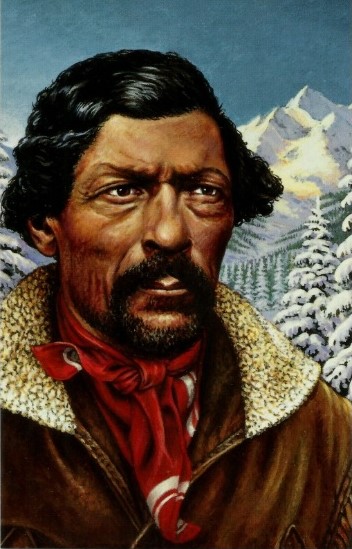

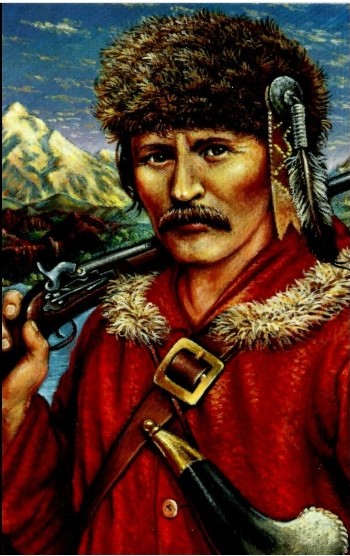



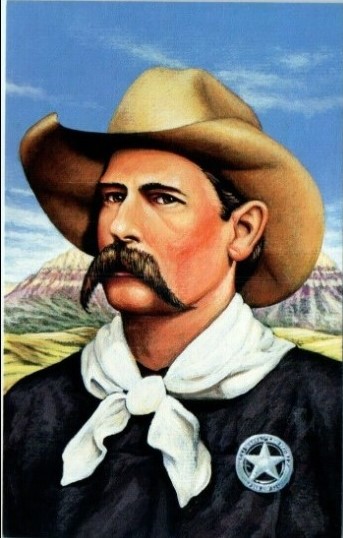

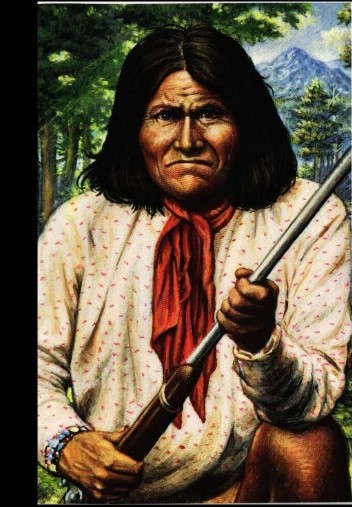
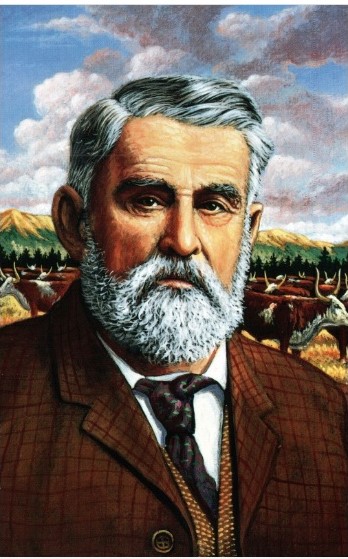
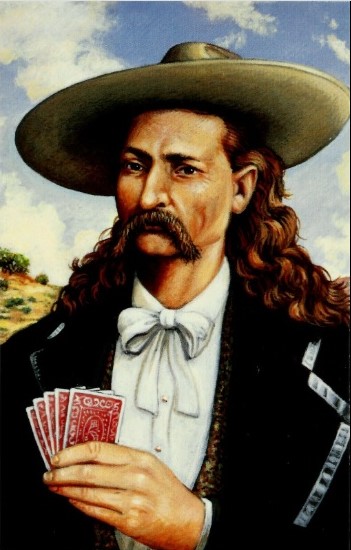

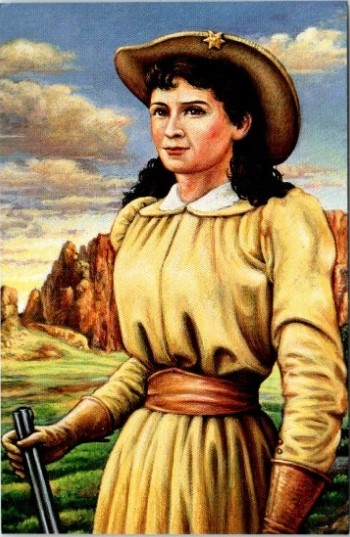
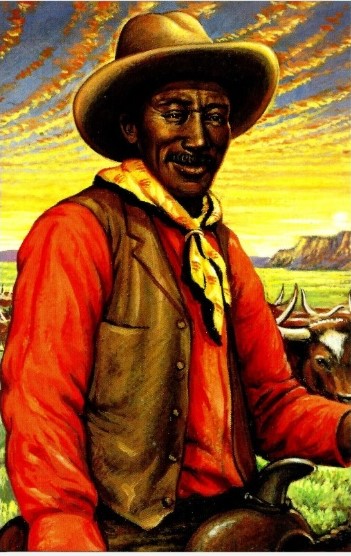

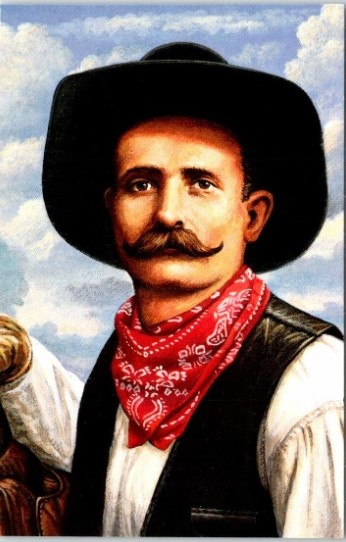
I’m a big Annie Oakley fan, and this rendition of her is a poor likeness. I think these are, art-wise, all “over worked”.
I remember this set of stamps and the cards and the hubbub over the likeness of Bill Pickett not being right and then it was corrected. Many of these individuals were in a series of biographies I checked out of our grade school library, and read. Those were the days when I wished I was a cowboy. I got over that thought after riding a horse several times. I just did not “fit into a saddle.”
A very fine article that should have wider coverage. May I reproduce it in the San Jose Stamp Club and San Jose Post Card Club’s newsletters?
Sir:
If you care to reproduce this article, please do so along with a credit to the Editors at Postcard History Online Magazine. Also, you should encourage all your members who have computers to check-in at <postcardhistory.net> every Thursday for the four articles we publish each week.
Great article, the staff of Post Card History should be very proud of the job you have done. I have never seen one of these post cards, but you can be sure I will be on the lookout now.
I first heard of Goodnight when a TV show (“Room 222” if memory serves correctly) made a snickering reference to the Goodnight-Loving Trail , which was named after Charlie and fellow cattleman Oliver Loving.